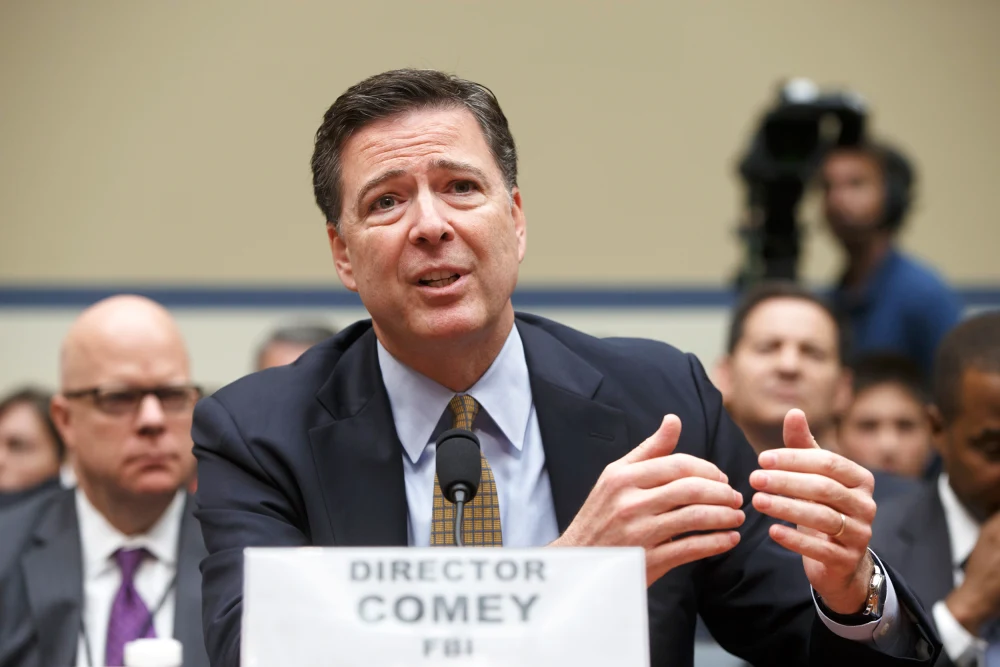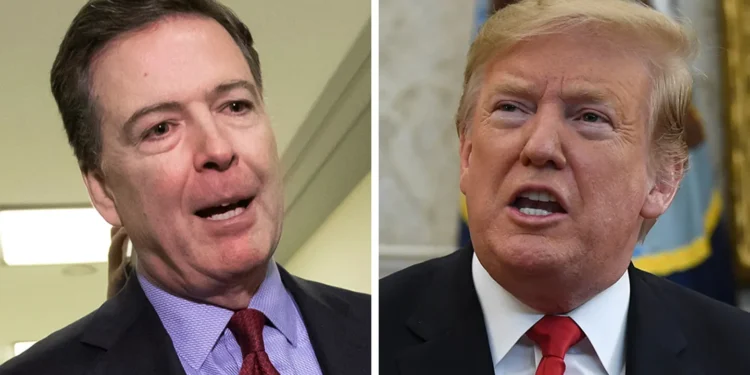The controversy surrounding former FBI Director’s recent social media activity has sparked intense debate. A recent post on Instagram has been at the center of the storm, with many interpreting it as a call to action against the current administration.

The post in question has raised concerns about potential threats to the President, leading to an investigation by the Secret Service. The image and caption posted by the ex-FBI Chief have been scrutinized, with many questioning the implications of his actions.
The Trump administration has reacted strongly to the post, fueling the controversy. As the investigation unfolds, the public remains engaged, seeking clarity on the matter.
Key Takeaways
- The Secret Service is investigating a recent post by the former FBI Director.
- The post was interpreted by many as a call to action against President Trump.
- The controversy has sparked a heated debate about the implications of the post.
- The Trump administration has responded strongly to the ex-FBI Chief’s actions.
- The investigation aims to clarify the intentions behind the post.

The Controversial “86 47” Post: What Exactly Did James Comey Share?
A seemingly innocuous beach photo posted by James Comey on Instagram turned into a controversy overnight. The post, which featured a collection of seashells arranged in a specific pattern on the sand, was captioned “Cool shell formation on my beach walk…”. This harmless-sounding update, however, belied a more complex and contentious issue.
The Beach Photo and Its Caption
The image in question showed seashells arranged to spell out “86 47.” Comey’s caption, “Cool shell formation on my beach walk…”, did not hint at any deeper meaning behind the numbers. The post was made on a Sunday, and by the next day, it had garnered significant attention, sparking debate and speculation.
Decoding “86 47”: The Alleged Hidden Meaning
The numbers “86 47” have been interpreted by many as having a sinister connotation, potentially referencing a threat against Donald Trump, the 47th President of the United States, with “86” possibly being slang for “getting rid of” or “killing.” Comey later claimed he was unaware of any hidden meaning associated with these numbers when he posted the image.
Timeline of the Post and Its Deletion
Comey’s post was made on a Sunday morning. By Monday, it had gained significant traction, with many users criticizing or interpreting the post in various ways. As the controversy grew, Comey deleted the post, stating he didn’t realize the numbers were associated with any violent or threatening connotations. The quick deletion, however, did little to quell the speculation and outrage, with many viewing it as too late, given the post had already been widely shared and discussed.
Understanding the Terminology: What Does “86 47” Mean?
To grasp the severity of James Comey’s recent social media post, it’s essential to understand the terminology “86 47.” This term has been at the center of a heated debate, with many questioning its significance and potential threat to former President Donald Trump.
The term “86 47” is a combination of two distinct elements: “86” and “47.” Understanding each component is crucial to deciphering the overall meaning.
The Origin and Evolution of “86” in American Slang
The term “86” has its roots in American slang, originally meaning to “get rid of” or “refuse service to” someone. Over time, its meaning has evolved, and it is now often associated with more violent connotations, such as “to kill” or “eliminate.” This shift in meaning is significant, as it changes the context in which the term is used.
As noted by linguists, the evolution of slang terms like “86” reflects cultural and societal changes, often becoming more pronounced during times of social unrest.
Merriam-Webster’s Note on Violent Usage
Merriam-Webster has acknowledged the increasingly violent usage of “86,” noting its association with aggressive or harmful actions. This recognition highlights the term’s potential to incite or glorify violence.
“The term ’86’ has taken on a more sinister meaning, often implying a threat or an act of violence against an individual or group.”
The Significance of “47” in Reference to Trump
The number “47” refers to Donald Trump’s status as the 45th President of the United States, although some sources may conflate it with his being the 47th president in some contexts, it’s more about referencing him directly. In this context, “47” is used to directly reference or allude to Trump, making the term “86 47” potentially threatening or harmful towards him.
Understanding the dual components of “86 47” is vital to assessing the controversy surrounding James Comey’s post and its potential implications.
White House and Secret Service Response to Comey’s Post
James Comey’s recent ’86 47′ post has triggered a swift response from both the White House and the Secret Service. The controversy surrounding the post has raised concerns about its potential implications for former President Trump.
Official White House Statement
The White House has condemned Comey’s post, with Deputy Chief of Staff Taylor Budowich calling it “a hit” on Trump. This strong reaction underscores the White House’s stance on the matter, emphasizing the seriousness with which they view the post.
Budowich’s statement highlights the White House’s commitment to protecting the former President’s safety and reputation. The use of the term “a hit” suggests a perceived threat or danger, which has likely prompted further action.
Secret Service Investigation Protocol
In response to Comey’s post, the Secret Service has opened an investigation. This move is part of their protocol to assess potential threats to former President Trump and other protected individuals.
The investigation will likely involve examining Comey’s intentions behind the post, as well as assessing whether it constitutes a credible threat. As part of this process, Comey may be interviewed to provide context and clarify his intentions.
| Entity | Response | Key Actions |
|---|---|---|
| White House | Condemnation of Comey’s post | Statement by Taylor Budowich |
| Secret Service | Investigation into the post | Assessment of threat credibility, potential interview with Comey |
The response from both the White House and the Secret Service demonstrates the seriousness with which Comey’s post is being treated. As the investigation unfolds, further details are likely to emerge regarding the implications of the post and any potential actions to be taken.
Trump Allies Rally Against James Comey’s “86 47” Post
The reaction from Trump allies has been swift and severe following James Comey’s controversial “86 47” post. This backlash is led by prominent figures within the Trump camp, who are vocal in their criticism of Comey’s actions.
Donald Trump Jr.’s Accusation of “Calling for Murder”
Donald Trump Jr. has been at the forefront of the criticism, accusing Comey of effectively calling for murder with his post. He has taken to social media to express his outrage, stating that Comey’s actions are irresponsible and dangerous.
Kristi Noem and DHS Involvement
Kristi Noem, another key ally of Trump, has also weighed in on the controversy. She has suggested that the Department of Homeland Security (DHS) should investigate Comey’s post, highlighting the potential security implications of his actions.

Rep. Tim Burchett’s Call to “Arrest Comey”
Rep. Tim Burchett has taken a more aggressive stance, calling for Comey’s arrest. He argues that Comey’s post constitutes a threat against a former President and should be treated as such under the law.
| Trump Ally | Statement/Action |
|---|---|
| Donald Trump Jr. | Accused Comey of “calling for murder” |
| Kristi Noem | Suggested DHS investigation into Comey’s post |
| Rep. Tim Burchett | Called for Comey’s arrest |
The unified response from Trump allies underscores the deep-seated divisions within the political landscape. As the situation continues to unfold, it remains to be seen how Comey will respond to these allegations and whether they will have any lasting impact on his reputation or lead to further action.
Comey’s Defense and Explanation of the Controversial Post
In response to the backlash, James Comey issued a statement clarifying his intentions behind the ’86 47′ post. The controversy surrounding the post has raised questions about Comey’s understanding of the terminology and his stance on violence.
Official Statement: “I Oppose Violence of Any Kind”
Comey’s official statement emphasized his opposition to violence in any form. He stated,
“I oppose violence of any kind. My post was not intended to promote or condone violence.”
This statement aims to reassure the public of his commitment to non-violent principles.
Analysis of Comey’s Claim of Ignorance About the Terminology
Comey claimed he was unaware of the violent connotations associated with the ’86 47′ terminology. An analysis of his claim reveals that it hinges on the interpretation of his actions and intentions. The table below summarizes the key points of Comey’s defense and the reactions to it.
| Aspect | Comey’s Defense | Public Reaction |
|---|---|---|
| Intent | Opposition to violence | Skepticism about his true intentions |
| Understanding of Terminology | Claimed ignorance of violent connotations | Debate over plausibility |
| Official Statement | Issued a statement opposing violence | Mixed reactions; some believe, others remain skeptical |
The controversy highlights the complexities of interpreting public statements and the importance of understanding the context and potential implications of the terminology used. Comey’s defense strategy includes emphasizing his opposition to violence, but the public remains divided on the issue.

The History Between James Comey and Donald Trump
The tension between James Comey and Donald Trump escalated significantly after Comey’s firing in 2017. This event marked a turning point in their relationship, leading to a series of public criticisms and counter-statements.
Comey’s Firing in 2017 and Its Aftermath
On May 9, 2017, Donald Trump fired James Comey as the Director of the FBI, citing the recommendation of Attorney General Jeff Sessions and Deputy Attorney General Rod Rosenstein. The reason given was Comey’s handling of the investigation into Hillary Clinton’s emails. However, it was later revealed that Trump had other motivations, including Comey’s refusal to end the FBI’s investigation into Trump’s ties to Russia.
This firing was met with widespread criticism, with many viewing it as an attempt by Trump to obstruct justice. The aftermath saw Comey testify before Congress, providing details about his interactions with Trump and the reasons behind his dismissal.
Previous Public Statements and Criticisms Between the Two
Before his firing, Comey had already faced criticism from Trump for his handling of the FBI investigations. Trump had publicly clashed with Comey on several occasions, expressing dissatisfaction with the FBI’s direction under Comey’s leadership.
After being fired, Comey became more vocal about his disagreements with Trump. In his memoir, “A Higher Loyalty,” Comey detailed his experiences with Trump, portraying him as unfit for office. Trump responded by criticizing Comey on Twitter and during public appearances, accusing him of being a “liar” and “leaker.”

Recent Attempts on Trump’s Life: Contextualizing the “James Comey 86 47” Controversy
In light of the “James Comey 86 47” controversy, recent events have highlighted the escalating issue of political violence in the United States. The nation has witnessed a surge in threats and attempts on political figures, particularly against Donald Trump.
The July 2024 Pennsylvania Rally Shooting
The July 2024 Pennsylvania rally shooting was a significant incident that highlighted the growing concern of political violence. Trump was targeted in an assassination attempt during a rally, resulting in heightened security measures across the country. This incident has been a focal point in discussions about the safety of political figures and the potential consequences of inflammatory rhetoric.
The Foiled Mar-a-Lago Plot
Another alarming incident was the foiled Mar-a-Lago plot, where a detailed plan to assassinate Trump was uncovered. The plot underscored the serious threats faced by former presidents and the need for robust security protocols. Investigations revealed a complex web of individuals involved, raising questions about the extent of the threat and how it was mitigated.

John Mulaney’s 2020 SNL Caesar Joke Investigation
Even seemingly trivial incidents, like John Mulaney’s 2020 SNL Caesar joke, have been subject to intense scrutiny. The joke, which was perceived as threatening to Trump, led to an investigation into whether it constituted a credible threat. This incident highlights how humor and satire are being closely monitored in the current political climate.
| Incident | Date | Outcome |
|---|---|---|
| July 2024 Pennsylvania Rally Shooting | July 2024 | Assassination attempt foiled, heightened security |
| Foiled Mar-a-Lago Plot | 2024 | Plot uncovered, suspects investigated |
| John Mulaney’s SNL Joke | 2020 | Investigation into credibility of threat |
The “James Comey 86 47” controversy must be understood within this context of escalating political tensions and violence. As the nation grapples with these issues, it is crucial to examine the interplay between political rhetoric, social media, and real-world actions.
Legal Implications: Could James Comey Face Charges?
The “86 47” post by James Comey has led to a thorough examination of its legal ramifications. As the investigation unfolds, it’s crucial to understand the legal framework surrounding threats against a president or former president.
Federal Laws on Threatening a President or Former President
Under federal law, threatening a president or former president is a serious offense. 18 U.S.C. § 871 makes it a crime to knowingly and willfully make a threat against the President or other officials. The law is designed to protect public figures from harm.
| Statute | Description | Penalty |
|---|---|---|
| 18 U.S.C. § 871 | Threatening the President | Up to 5 years imprisonment |
| 18 U.S.C. § 879 | Threats against former Presidents | Up to 5 years imprisonment |
Burden of Proof: Intent vs. Plausible Deniability
A critical aspect of any potential case against Comey is the burden of proof. Prosecutors must demonstrate that Comey’s post was intended as a threat, rather than a figure of speech or joke. The distinction between intent and plausible deniability will be crucial in determining whether charges can be brought.
Precedents in Similar Cases
There have been several cases where individuals have faced charges for threatening public figures. For instance, in United States v. Turner, a defendant was convicted for making threats against a government official. Analyzing these precedents will help understand the potential legal outcomes for Comey.
The investigation into Comey’s “86 47” post is ongoing, and the legal implications are complex. As the case unfolds, it will be essential to monitor how the legal system addresses the nuances of intent and threat in the context of social media.
Political Violence in America: A Growing Concern
Political violence in America is becoming a growing concern, with incidents and threats against political figures on the rise. This trend is not only alarming but also poses significant challenges to the nation’s political discourse and security measures.
The increasing polarization and divisive rhetoric have contributed to an environment where violence and threats are becoming more normalized. It is crucial to understand the factors driving this trend to mitigate its impact.
The Rise in Threats Against Political Figures
There has been a noted increase in threats against political figures, including elected officials and former government employees like James Comey. These threats range from verbal abuse on social media to more serious physical threats that necessitate Secret Service intervention.
Recent incidents have highlighted the gravity of the situation, with some threats being taken seriously enough to warrant investigations and protective measures.
How Social Media Amplifies Political Tensions
Social media platforms have become significant amplifiers of political tensions. The rapid dissemination of information, whether accurate or not, can quickly escalate tensions and provoke violent responses.
The viral nature of social media content means that inflammatory or provocative posts can reach a wide audience in a short time, contributing to the normalization of aggressive rhetoric and, in some cases, violence.
Furthermore, the anonymity offered by some platforms can embolden individuals to make threats they might not otherwise make in person.
Media and Public Reaction to the Controversy
As news of James Comey’s controversial “8647” post broke, the media and public reactions poured in, reflecting a wide range of perspectives. The intensity of the response was palpable across various media platforms.
How Different News Outlets Framed the Story
Different news outlets approached the story with varying degrees of scrutiny and interpretation. For instance, Fox News focused on the potential threat to former President Trump, while The New York Times examined the historical context of the terminology used.
- Conservative outlets emphasized the perceived threat to Trump.
- Liberal media focused on Comey’s explanation and the context of his post.
Social Media Reactions and Hashtag Trends
Social media platforms were abuzz with reactions to Comey’s post, with hashtags like #ComeyControversy and #8647 trending on Twitter. The public’s response was mixed, with some users calling for Comey to be held accountable, while others defended his right to free speech.
- Twitter users criticized Comey’s post as irresponsible.
- Supporters of Comey argued that his post was taken out of context.
Divided Public Opinion on Comey’s Intent
The public’s interpretation of Comey’s intent was sharply divided. Some saw his post as a veiled threat against Trump, while others viewed it as an innocuous social media post blown out of proportion.
- Some believed Comey was genuinely opposed to violence.
- Others thought he was inciting tension.
Conclusion: The Impact on Political Discourse and Security Concerns
The controversy surrounding James Comey’s “8647” post has highlighted the tense political climate and raised significant security concerns. The incident has sparked a heated debate about the implications of such posts on political discourse and the potential threats to public figures.
The impact on political discourse is multifaceted, with some viewing Comey’s post as a call to violence, while others see it as a harmless joke. However, the White House and Secret Service have taken the matter seriously, launching an investigation into the matter.
The security concerns surrounding this incident are valid, given the recent attempts on Trump’s life. The “8647” controversy underscores the need for responsible communication in the public sphere, particularly in the age of social media, where posts can be quickly misinterpreted or amplified.
As the investigation unfolds, it remains to be seen how this incident will affect the broader political landscape. One thing is certain: the need for thoughtful and considerate communication has never been more pressing.
FAQ
What does “8647” mean, and why is James Comey being investigated for his post?
The term “8647” is believed to be a coded threat against Donald Trump, with “86” being slang for “getting rid of” or “killing” someone, and “47” referring to Trump. James Comey is being investigated for potentially threatening Trump with his post.
What was the content of James Comey’s controversial Instagram post?
Comey posted a photo of seashells on the beach with the caption “86 47.” The post was later deleted, sparking controversy and investigation.
How did the Trump administration react to Comey’s “8647” post?
The Trump administration and allies reacted strongly, accusing Comey of threatening Trump and calling for action against him. Taylor Budowich, a White House official, made a statement regarding the matter.
Is the Secret Service investigating James Comey, and could he be interviewed?
Yes, the Secret Service is investigating Comey’s post as part of their protocol for handling threats against protected individuals, including former President Trump. It is possible that Comey could be interviewed as part of this investigation.
What are the legal implications for James Comey regarding his “8647” post?
Comey could potentially face charges if his post is deemed a credible threat against Trump. Federal laws prohibit threatening a president or former president, and the investigation will determine whether Comey’s post meets this criteria.
How have Trump allies responded to Comey’s post, and what actions are they demanding?
Trump allies, including Donald Trump Jr., Kristi Noem, and Rep. Tim Burchett, have strongly condemned Comey’s post, accusing him of “calling for murder” and demanding his arrest.
What is Comey’s defense regarding the “8647” controversy?
Comey has stated that he opposes violence of any kind and claimed ignorance about the violent connotations associated with the term “86.” His defense hinges on his intent behind the post and whether he was aware of the potential threat it posed.
What is the historical context between James Comey and Donald Trump?
Comey was fired by Trump in 2017, and since then, both parties have made public criticisms and statements against each other. This history is relevant to understanding the current controversy.
How has the media and public reacted to the “8647” controversy?
The media and public reactions have been divided, with different news outlets framing the story in various ways, and social media reactions reflecting a broad range of opinions on Comey’s intent and the severity of the situation.
What are the broader implications of the “8647” controversy for political discourse and security?
The controversy highlights the growing concern of political violence in America, the role of social media in amplifying tensions, and the need for responsible communication in the public sphere to prevent such incidents.





















































